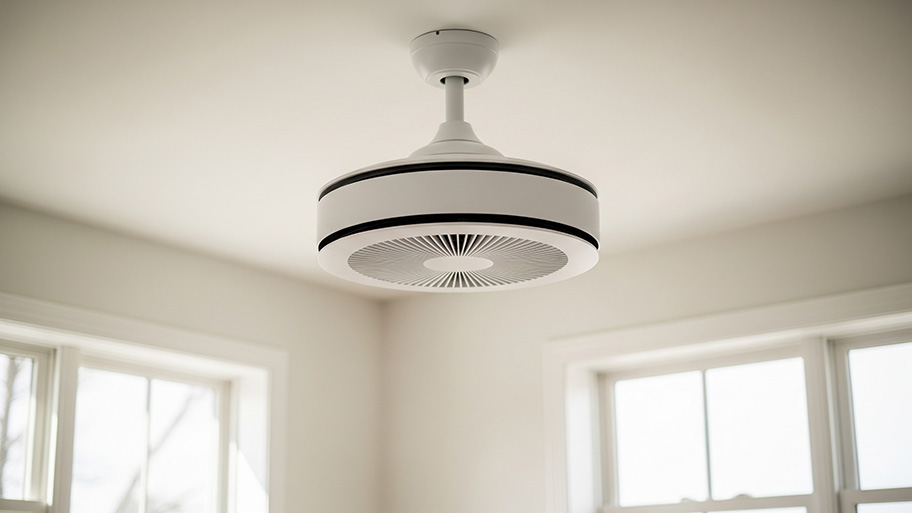
Discover the cost to install a ceiling fan, including labor, materials, and tips to save. Learn what impacts your price and how to budget for your project.
Stay frosty all summer long by installing the right home cooling combo


Whole-house fans are cost-efficient
They work best in dry and cool to moderate climates
Can be used in conjunction with AC to reduce energy costs
Whole-house fans cost much less to run than AC units, but saving money loses its appeal when you're sweltering in the long, humid summer days. If you live somewhere that's dry and cool, a whole-house fan is a great choice, but in hot, humid climates, AC is the better option.
Alternatively, you can install both a fan and an AC unit. Keep reading to find out which is the best option for your home.
A whole-house fan works by drawing in cool air from outside and expelling hot air through an exhaust usually vented through the roof. You open the windows downstairs during the coolest part of the day or evening and turn on the fan.
This creates airflow, allowing the fan to exchange the hot stale air from inside your home with the cooler, fresh air from outside. Then, before the heat of the day really gets going, you turn off the fan and close all the windows, trapping the cool air inside.
The biggest attraction of a whole-house fan is its comparatively low operating costs. A whole-house fan typically costs between $0.01 and $0.05 per hour to run, depending on where you live.
Compared to the cost of running an average AC system at $0.25 to $0.88 per hour, this makes a whole-house fan much more affordable. Plus, with a central air system, you'll also need to budget for the cost of annual AC servicing at $75 to $200.
They're easier and less expensive to install than other options, they start to cool your home rapidly, and they improve indoor air quality. Plus, because whole-house fans use less energy and don't contain any freon, they're more environmentally friendly.
While whole-house fans and air conditioning units are the two most popular cooling choices, geothermal cooling systems are becoming more common. Take a look at the key features of all three types to help you choose.

While the reduced energy costs and the price to install a whole-house fan makes it an attractive option, it may not be right for your climate. Because whole-house fans essentially work by exchanging indoor air with outdoor air, their effectiveness is limited.
Think about it: If you live somewhere where the outdoor air is hotter, as hot, or more humid than the air inside, bringing that air into your home won't help cool it. Instead, you'll just be paying to move hot air around.
Worse: You'll be paying to make your indoor air humid and sticky. Hence, if a whole-house fan is your only source of cooling, it's not a good choice for hot, humid climates.
Central air conditioning is the best choice for humid climates because it removes heat and moisture from the air. Geothermal cooling is another solid option that helps to reduce humidity, but it may still need some help from a dehumidifier.
Both options are more efficient at making your home comfortably cool and dry than a whole house fan. The caveat is that installing air conditioning costs considerably more than putting in a whole house fan, as is the price to install a geothermal system.
Plus, unlike a fan, you can't install a central AC or geothermal system yourself. Instead, you'll need to hire a local HVAC pro.
There is a way to enjoy a comfortably cool home, even in a hot, humid climate and still make use of a fan. And that's to use an AC system in conjunction with a whole-house fan. That way, on cooler, less humid days, or during cooler times of the day, you can use the fan.
This not only cools your home but also ensures you've got fresh air coming in for improved air quality. Then, when the heat of the day sets in and it's getting a little uncomfortable inside, you can switch the AC on for a few hours.
Using both cooling systems maximizes your ability to stay cool, optimizes your energy savings, and reduces your carbon footprint without you having to suffer in sticky, sweaty silence.
From average costs to expert advice, get all the answers you need to get your job done.

Discover the cost to install a ceiling fan, including labor, materials, and tips to save. Learn what impacts your price and how to budget for your project.

If your ceiling fan stops working due to a bad motor or broken pull chain, here’s what you can expect to pay to get it fixed.

Ceiling fans should run fairly quietly. Learn about the causes of excessive rattling, clicking, or other odd sounds and how to fix your noisy ceiling fan.

Are traditional ceiling fans slowly becoming a thing of the past? The famously quiet and efficient bladeless fans are now appearing right above our heads.

Looking to cool down a room or get some more air flowing throughout the house? Learn how to install a ceiling fan without existing wiring.

Does your ceiling fan wobble every time you turn it on? Use this guide to locate the source of the problem and learn how to balance a ceiling fan yourself.